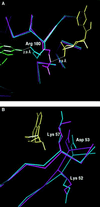The structure of a CAP-DNA complex having two cAMP molecules bound to each monomer
- PMID: 9096308
- PMCID: PMC20284
- DOI: 10.1073/pnas.94.7.2843
The structure of a CAP-DNA complex having two cAMP molecules bound to each monomer
Abstract
The 2.2 A resolution crystal structure of the Escherichia coli catabolite gene activator protein (CAP) complexed with cAMP and a 46-bp DNA fragment reveals a second cAMP molecule bound to each protein monomer. The second cAMP is in the syn conformation and is located on the DNA binding domain interacting with the helix-turn-helix, a beta-hairpin from the regulatory domain and the DNA (via water molecules). The presence of this second cAMP site resolves the apparent discrepancy between the NMR and x-ray data on the conformation of cAMP, and explains the cAMP concentration-dependent behaviors of the protein. In addition, this site's close proximity to mutations affecting transcriptional activation and its water-mediated interactions with a DNA recognition residue (E181) and DNA raise the possibility that this site has biological relevance.
Figures





References
-
- deCrombrugghe B, Busby S, Buc H. Science. 1984;224:831–838. - PubMed
-
- Crothers D M, Steitz T A. Transcriptional Activation by Escherichia coli CAP Protein. Plainview, NY: Cold Spring Harbor Lab. Press; 1992. pp. 501–534.
-
- Kraulis P J. J Appl Cryst. 1991;24:946–950.
-
- McKay D B, Steitz T A. Nature (London) 1981;290:744–749. - PubMed
Publication types
MeSH terms
Substances
Associated data
- Actions
Grants and funding
LinkOut - more resources
Full Text Sources
Molecular Biology Databases
Miscellaneous

